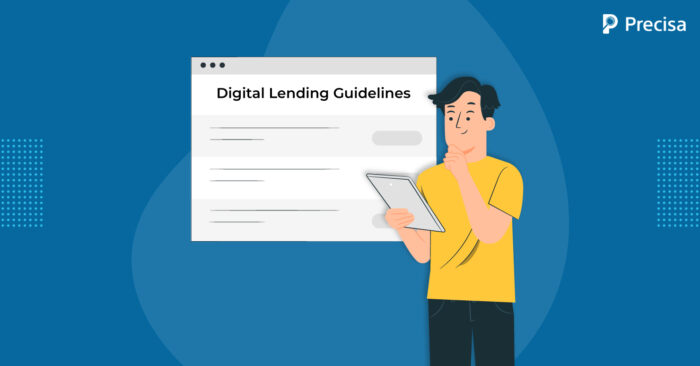RBI’s Digital Lending Guidelines for Borrowers and Lenders: Pros and Cons

The booming fintech ecosystem in India has led to the emergence of countless companies that offer various credit services.
However, despite its benefits, this expanding fintech vista has also led to the proliferation of unregulated digital lenders conducting unethical business, excessive third-party engagement, and rising risks to digital privacy. Moreover, unjust interest rates and inhumane tactics employed by claptrap fintech firms affect thousands of customers.
To counter the unsettling impact of the unchecked fintech uprising, the Reserve Bank of India (RBI) has issued a comprehensive set of guidelines. These guidelines cover a wide range of aspects, including lending processes, disclosures, technology, and data collection, as well as enabling customers to receive digital loans directly into their bank accounts without the involvement of third parties.
Let us discuss some aspects of the digital lending guidelines in this blog.
What Are RBI’s New Digital Lending Guidelines?
The new guidelines will cover lending processes, disclosures, and technology. For example, they dictate the data-gathering process by regulated entities, their digital lending applications, and their lending service providers.
Besides that, the guidelines also state:
- All loans must be disbursed and repaid from borrowers’ bank accounts to regulated entities such as banks and NBFCs.
- The RBI had stated that all fees, charges, etc., payable to lending service providers (LSP) in the credit intermediation process should be paid directly by regulated entities (REs) and not by borrowers.
- According to the RBI, a standardised key fact statement should be provided to the borrower by the REs as part of the loan contract.
- An annual percentage rate (APR) will be given to borrowers to represent the total cost of digital loans.
- The loan contract must include a cooling-off/look-up period during which borrowers can exit digital loans by paying the principal and proportionate APR without penalties.
- To increase the credit limit, the borrower must consent to the increase. Automatic credit increases without consent would be prohibited.
- According to the central bank, all participating REs should have a nodal grievance redressing officer responsible for handling fintech/digital lending complaints.
Such grievance redressal officers may also address digital lending complaints.
Pros and Cons of RBI’s Digital Lending Guidelines for Borrowers and Lenders
The RBI released the Digital Lending Guidelines to regulate India’s digital lending sector. The guidelines aim to ensure fairness and transparency in digital lending and provide a framework for the protection of borrowers.
Let’s learn about some of the pros and cons of these guidelines for borrowers and lenders.
What Borrowers Can Expect
1. Increased Transparency
The guidelines mandate digital lenders to disclose all relevant information related to the loan, such as interest rates, fees, charges, and other terms and conditions, in clear and simple language. This will help borrowers make informed decisions and avoid hidden charges or unexpected costs.
2. Protection Against Unfair Practises
The guidelines prohibit digital lenders from engaging in unfair practices such as harassment, coercion, and undue influence to recover loans, ensuring that borrowers are treated humanely.
3. Grievance Redressal Mechanism
The guidelines require digital lenders to establish a robust grievance redressal mechanism for borrowers. This will enable borrowers to raise their concerns and grievance and seek resolution promptly and effectively.
A Few Cons for Borrowers
1. Reduced Access to Credit
The guidelines mandate stricter eligibility criteria and due diligence requirements for borrowers. This may result in some borrowers being denied access to credit, especially those with a poor credit history or lack of collateral.
2. Longer Approval Time
The guidelines require digital lenders to undertake more stringent due diligence and verification processes before approving a loan, resulting in longer approval times.
Some Benefits of Digital Lending for Lenders
1. Increased Credibility
The guidelines are expected to improve the credibility of digital lending platforms in the eyes of borrowers and investors. This could lead to an increase in business for lenders and help them to attract more investors.
2. Regulatory Clarity
The guidelines provide regulatory clarity for digital lenders, helping them better understand their legal and regulatory obligations. This will help lenders to avoid any non-compliance issues and reduce legal risks.
- Standardisation
By establishing guidelines, lenders can operate on an equal playing field in the digital lending space, which will help them become more competitive in the future.
Cons for Lenders
1. Increased Compliance Costs
The guidelines require digital lenders to implement various processes and systems to comply with regulatory requirements. This may result in higher compliance costs, which could affect the profitability of digital lending platforms.
2. Reduced Flexibility
The guidelines limit the flexibility of digital lenders in terms of interest rates, fees, and charges. Consequently, it becomes difficult for lenders to adapt to changing market conditions and compete effectively with other lenders.
3. Competition
The guidelines could enable more players to enter the digital lending market, increasing competition for existing players.
Wrapping Up
Despite the challenges, the RBI guidelines are a step towards creating a stable and trustworthy lending environment. As long as the guidelines are implemented effectively and reviewed regularly to adapt to changing market conditions, they can help to prevent financial crises and promote sustainable economic growth.
The digital lending industry is rapidly evolving with the aid of fintech, as innovative technologies such as blockchain and machine learning are helping make it possible to create new forms of lending. It makes the borrowing experience more convenient, faster, and personalised for consumers as a result of fintech.
Cutting-edge fintech tools such as Precisa offers quick bank statement analysis to borrowers and lenders that allows them to save a lot of time by saving them a lot of time. Additionally, it helps in retrieving real-time data through Account Aggregators (AAs) integrations, enabling more precise decision-making for lenders and borrowers.
Sign up for a free trial of Precisa to find out more.



